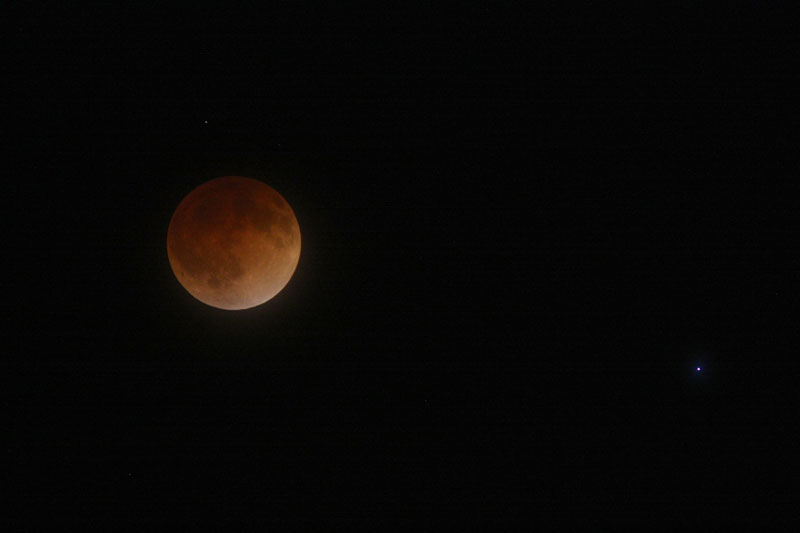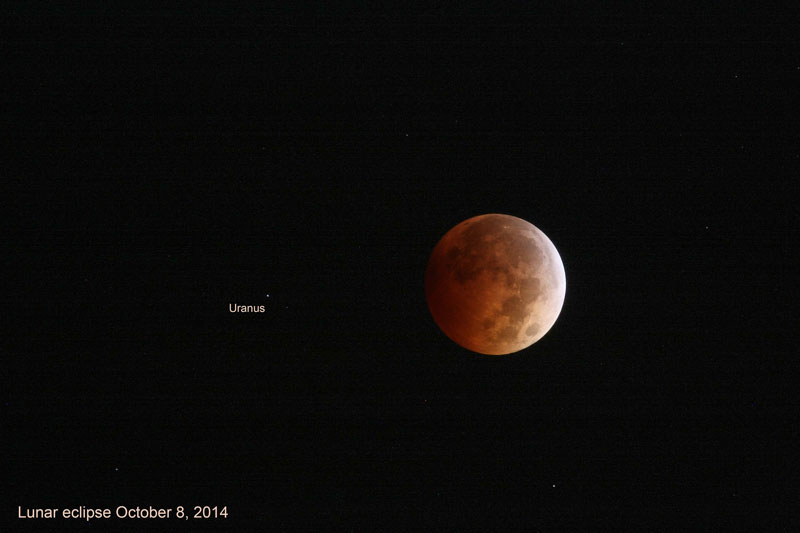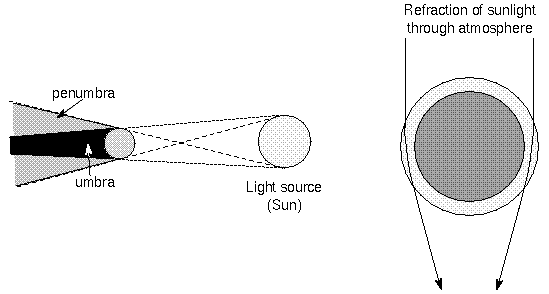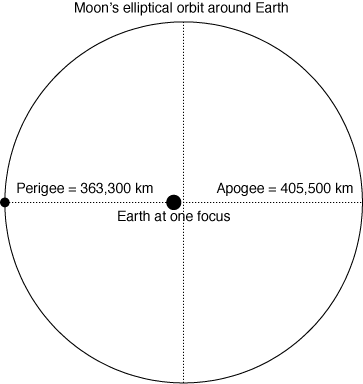
Lunar eclipse of April 2014 -- the bright star to the right of the Moon is Spica.

Lunar eclipse of October 2014
Video lecture for this chapter
Let's explore a little more about lunar and solar eclipses. Remember that an eclipse happens when an object passes through another object's shadow. Any shadow consists of two parts: an umbra which is the region of total shadow and the penumbra which is the outer region of partial shadow. If the Moon were to pass through the Earth's umbra, an observer on the Moon would not be able to see the Sun at all---she would observe a solar eclipse! An observer on the Earth looking at the Moon would see a total lunar eclipse. The Earth's shadow is pretty big compared to the Moon so a total lunar eclipse can last up to about 1 hour 45 minutes.
If the Moon only passed through the outer part of the shadow (the penumbra), then the observer on the Moon would see the Sun only partially covered up---a partial solar eclipse. The observer on the Earth would see the Moon only partially dimmed---a partial lunar eclipse. The total lunar eclipses of 2014 are shown below.
Lunar eclipse of April 2014 -- the bright star to the right of the Moon is Spica. |
Lunar eclipse of October 2014 |
Below is a sequence of images from the August 28, 2007 lunar eclipse taken with a digital camera at the highest zoom setting put into a movie file. The dark red-orange color is the color I saw.
During a total lunar eclipse you see another interesting effect---the Moon turns a coppery (or bloody) red. The reason why some sunlight reaches the Moon despite the fact that the Moon is in the Earth's umbra is that the sunlight refracts or bends as it passes through the Earth's atmosphere. Dust particles in the Earth's atmosphere remove much of the bluer colors in the sunlight so only the redder colors make it to the Moon. The amount of dust determines the deepness of the red colors. The dust in the air is also why the Sun appears redder at sunset on Earth. The observer on the Moon would see a reddish ring around the Earth even at mid-eclipse! Some nice visualizations of the lunar eclipse essentials are available at Goddard Space Flight Center's Lunar Eclipse Essentials page. Also, see NASA's Scientific Visualization Studio's animation of the Moon moving through the Earth's shadow for the May 26, 2021 total lunar eclipse and the telescope view.

Select the images to view full-size versions. The first total solar eclipse image above is a combination of exposures in an attempt to capture the fuller range of what the human eye could see but, even still, the prominences were easier to see than what the image shows. The second total solar eclipse figure shows two of the exposures used to create the first image. The short exposure image on the left makes it easier to see the prominences sticking out from behind the 12 o'clock, 1:30 o'clock, and 3 o'clock edges of the dark Moon.
Unfortunately, only the tip of the Moon's umbra reaches the Earth (the tip hitting the Earth is at most 270 kilometers [168 miles] in diameter) and it zips along the Earth's surface at over 1600 kph (1000 mph) as the Moon moves around the rotating Earth. This means that a total solar eclipse can last a maximum of only 7.5 minutes. Usually total solar eclipses last only 2-3 minutes. Because of the orbital motion of the Moon and the rotation of the Earth, the umbra makes a long, narrow path of totality. For example, the August 21, 2017 eclipse had a narrow path of totality about 109 kilometers (68 miles) wide from the northwest coast to the southeast coast of the United States as shown below. How this looked from space is available from this link to an MP4 video of EPIC images from the DSCOVR satellite (source link and annotated version on YouTube). NASA's Scientific Visualization Studio created a nice set of properly-scaled orbit animations of the March 2016 solar eclipse that show the tiny Moon umbra and tilt of the Moon's orbit.

Sometimes the umbra does not reach the Earth at all (only the penumbra) even though the Moon is on the ecliptic and it is exactly in New Moon phase. A bright ring will be visible around the Moon when it is lined up with the Sun---an annular eclipse (because of the annulus or ring of light around the Moon). What do you think this implies about the shape of the Moon's orbit?

The sequence below is of the May 20, 2012 annular solar eclipse as seen from Red Bluff, CA. Select the image to go to a full-size image of the eclipse sequence and an animation.
A video of the central 5 minutes of the total solar eclipse of November 13, 2012 as seen from Amaroo, outside of Cairns, Australia, is posted on YouTube. The video also shows that even astronomers have to contend with the weather. A video of images from the August 21, 2017 total solar eclipse as seen from Glendo State Park in Wyoming, USA is posted on YouTube. The video shows the Moon covering the Sun, different exposures during totality to highlight different parts of the eclipsed Sun, and the Moon uncovering the Sun. Another video of a wide-angle view of the August 2017 total solar eclipse shows the changing sky color and eclipsed Sun in real-time. Another video worth sharing from National Public Radio focuses on the effect on the eclipse on those who viewed the August 2017 eclipse from various places across the nation.
| annular eclipse | penumbra | refraction |
|---|---|---|
| umbra |
![]() Go back to previous section --
Go back to previous section --
![]() Go to next section
Go to next section
last updated: February 28, 2024